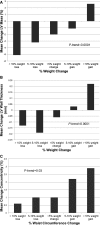Dynamic Relation of Changes in Weight and Indices of Fat Distribution With Cardiac Structure and Function: The Dallas Heart Study
- PMID: 28724650
- PMCID: PMC5586303
- DOI: 10.1161/JAHA.117.005897
Dynamic Relation of Changes in Weight and Indices of Fat Distribution With Cardiac Structure and Function: The Dallas Heart Study
Abstract
Background: Obesity may increase heart failure risk through cardiac remodeling. Cross-sectional associations between adiposity and cardiac structure and function have been elucidated, but the impact of longitudinal changes in adiposity on cardiac remodeling is less well understood.
Methods and results: Participants in the Dallas Heart Study without cardiovascular disease or left ventricular dysfunction underwent assessment of body weight, anthropometrics, and cardiac magnetic resonance imaging at baseline and 7 years later. Associations between changes in indices of generalized and central adiposity with changes in left ventricular mass, volume, mass/volume ratio (concentricity), wall thickness, and ejection fraction were assessed using multivariable linear regression. The study cohort (n=1262) mean age was 44 years with 57% women, 44% black, and 36% obese participants. At follow-up, 41% had ≥5% weight gain, and 15% had ≥5% weight loss. Greater weight gain was associated with younger age, lower risk factor burden, and lower body mass index at baseline. In multivariable models adjusting for age, sex, race, comorbid conditions at baseline and follow-up, baseline adiposity, and cardiac measurement, increasing weight was associated with increases in left ventricular mass (β=0.10, P<0.0001), wall thickness (β=0.10, P<0.0001), and concentricity (β=0.06, P=0.002), with modest effects on end-diastolic volume (β=0.04, P=0.044) and ejection fraction (β=0.05, P=0.046). Similar results were seen with other adiposity indices.
Conclusions: Concentric left ventricular remodeling is the predominant phenotype linked to increasing adiposity in middle age. Our findings support the importance of weight management to prevent secular changes in adiposity, concentric remodeling, and eventual heart failure over time.
Keywords: adipose tissue; body mass index; cardiac remodeling; dual x‐ray absorptiometry; magnetic resonance imaging; obesity; visceral adipose tissue; waist circumference.
© 2017 The Authors. Published on behalf of the American Heart Association, Inc., by Wiley.
Figures



Similar articles
-
Relation of regional fat distribution to left ventricular structure and function.Circ Cardiovasc Imaging. 2013 Sep;6(5):800-7. doi: 10.1161/CIRCIMAGING.113.000532. Epub 2013 Aug 8. Circ Cardiovasc Imaging. 2013. PMID: 23929898 Free PMC article.
-
Association between abdominal adiposity and subclinical measures of left-ventricular remodeling in diabetics, prediabetics and normal controls without history of cardiovascular disease as measured by magnetic resonance imaging: results from the KORA-FF4 Study.Cardiovasc Diabetol. 2018 Jun 12;17(1):88. doi: 10.1186/s12933-018-0721-0. Cardiovasc Diabetol. 2018. PMID: 29895299 Free PMC article.
-
Hemodynamic overload and intra-abdominal adiposity in obese children: Relationships with cardiovascular structure and function.Nutr Metab Cardiovasc Dis. 2016 Jan;26(1):60-6. doi: 10.1016/j.numecd.2015.10.002. Epub 2015 Nov 3. Nutr Metab Cardiovasc Dis. 2016. PMID: 26643211
-
Left ventricular hypertrophy and obesity: only a matter of fat?High Blood Press Cardiovasc Prev. 2015 Mar;22(1):29-41. doi: 10.1007/s40292-014-0068-x. Epub 2014 Aug 13. High Blood Press Cardiovasc Prev. 2015. PMID: 25117210 Review.
-
Crossroads between Estrogen Loss, Obesity, and Heart Failure with Preserved Ejection Fraction.Arq Bras Cardiol. 2021 Dec;117(6):1191-1201. doi: 10.36660/abc.20200855. Arq Bras Cardiol. 2021. PMID: 34644788 Free PMC article. Review. English, Portuguese.
Cited by
-
Physical Activity and Incident Heart Failure in High-Risk Subgroups: The ARIC Study.J Am Heart Assoc. 2020 May 18;9(10):e014885. doi: 10.1161/JAHA.119.014885. Epub 2020 May 11. J Am Heart Assoc. 2020. PMID: 32390492 Free PMC article.
-
Exploring the Mechanistic Link Between Obesity and Heart Failure.Curr Diab Rep. 2023 Dec;23(12):347-360. doi: 10.1007/s11892-023-01526-y. Epub 2023 Dec 15. Curr Diab Rep. 2023. PMID: 38100052 Review.
-
Risk of Heart Failure between Different Metabolic States of Health and Weight: A Meta-Analysis of Cohort Studies.Nutrients. 2022 Dec 8;14(24):5223. doi: 10.3390/nu14245223. Nutrients. 2022. PMID: 36558382 Free PMC article.
-
Cross-Sectional Associations of Objectively Measured Sedentary Time, Physical Activity, and Fitness With Cardiac Structure and Function: Findings From the Dallas Heart Study.J Am Heart Assoc. 2021 Feb;10(5):e015601. doi: 10.1161/JAHA.119.015601. Epub 2021 Feb 22. J Am Heart Assoc. 2021. PMID: 33615827 Free PMC article.
-
Body Fat Distribution, Overweight, and Cardiac Structures in School-Age Children: A Population-Based Cardiac Magnetic Resonance Imaging Study.J Am Heart Assoc. 2020 Jul 7;9(13):e014933. doi: 10.1161/JAHA.119.014933. Epub 2020 Jun 20. J Am Heart Assoc. 2020. PMID: 32567454 Free PMC article.
References
-
- Jensen MD, Ryan DH, Apovian CM, Ard JD, Comuzzie AG, Donato KA, Hu FB, Hubbard VS, Jakicic JM, Kushner RF, Loria CM, Millen BE, Nonas CA, Pi‐Sunyer FX, Stevens J, Stevens VJ, Wadden TA, Wolfe BM, Yanovski SZ. 2013 AHA/ACC/TOS guideline for the management of overweight and obesity in adults: a report of the American College of Cardiology/American Heart Association Task Force on Practice Guidelines and The Obesity Society. J Am Coll Cardiol. 2014;63:2985–3023. - PubMed
-
- Kenchaiah S, Evans JC, Levy D, Wilson PW, Benjamin EJ, Larson MG, Kannel WB, Vasan RS. Obesity and the risk of heart failure. N Engl J Med. 2002;347:305–313. - PubMed
-
- Abbasi F, Brown BW Jr, Lamendola C, McLaughlin T, Reaven GM. Relationship between obesity, insulin resistance, and coronary heart disease risk. J Am Coll Cardiol. 2002;40:937–943. - PubMed
-
- Lauer MS, Anderson KM, Kannel WB, Levy D. The impact of obesity on left ventricular mass and geometry. The Framingham Heart Study. JAMA. 1991;266:231–236. - PubMed
MeSH terms
Grants and funding
LinkOut - more resources
Full Text Sources
Other Literature Sources
Medical

